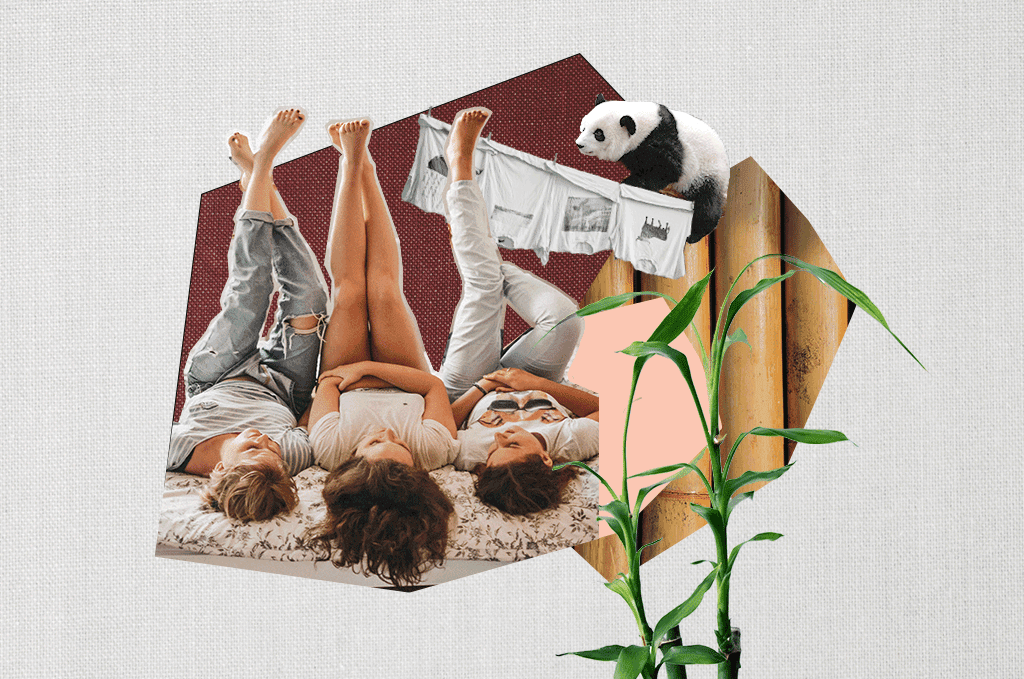What’s not to love about bamboo? The light and luxurious fabric is soft to touch, dreamy to wear and keeps pandas alive.
At first glance it sounds like a wonder material: a super soft fabric made from a fast-growing, pesticide-free plant. But is the end product that makes it into shops as sustainable as we’re told?
Bamboo fabric has plenty of claimed benefits: thermo-regulating, moisture wicking, naturally breathable, UV-protecting, anti-bacterial, hypoallergenic and anti static. But like so many other products, the way it’s sourced and processed from fibre into fabric has a darker side.
How sustainable are bamboo plantations?
Bamboo is the fastest growing woody plant in the world. Some varieties can grow as much as one metre a day. It regenerates, sending up new shoots after harvesting with no need to replant crops and plantations produce 30% more oxygen than an equal plantation of trees. They also absorb more carbon dioxide and other greenhouse gases than trees, and growing even commercial quantities of bamboo only requires rainwater.
Perhaps best of all, bamboo plants don’t require any pesticides, insecticides or fertilisers to grow. That means bamboo fabric is, more often than not, 100% organic. Compare this with cotton and you can easily see advantages.
So far so good. BUT before you swap everything in your wardrobe for bamboo fibre, consider the source. While bamboo plants are naturally pest resistant and can grow without chemical fertilisers or pesticides it doesn’t mean farmers aren’t spraying the crops to increase yield.
China is still the only country growing bamboo at commercial scale, and as it has been increasing in popularity, there is evidence farmers are chopping down forests for farmland or swapping less lucrative plants for bamboo. This reduces biodiversity, which could lead to an increase in pests, and eventually, more pesticides.
How is the fibre turned into material?
Green Story compared five supply chains used by bamboo clothing brand Boody with that of conventional cotton. The study found producing bamboo fabric created about 27% less greenhouse gas emissions, used 66% less water and 49% less energy. That’s the good news.
But the production process itself is a little less ecologically cheery.
There are two methods for turning bamboo into soft, silky bamboo fabric.
One method is mechanical. The bamboo is crushed into a mush before natural enzymes break it down and the fibres are finally combed and spun into a yarn. The resulting fabric is often called “bamboo linen” due to its similar texture to flax linen. Fabric made this way is more sustainable but it’s labour intensive, expensive and results in a more coarse material.
The second option is a highly chemical-intensive process. Significantly more popular, this method produces the silky “bamboo rayon” we know so well in soft T-shirts, underwear, sheets and more.
This chemical method starts with a solvent cocktail consisting mainly of sodium hydroxide and carbon disulfide. In a similar process to creating viscose fabric, the chemical mix dissolves the bamboo to create a pulpy substance. The pulp is spun into fibres that become yarn. Unfortunately the two chemicals I mentioned are seriously harmful to humans and marine life. While they are only used in a small part of the production process, just imagine the environmental and human impact of a big factory producing tonnes of bamboo fabric each year.
There is a glimmer of hope in bamboo fabric innovation though. Keep an eye out for Monocel®, a bamboo fabric created with the lyocell (or TENCEL®) method of production. This is a closed-loop process that recaptures and reuses 99% of all chemicals used in making the fabric.
Our verdict
Bamboo is a fast-growing, sustainable crop but once the bamboo stalks leave the field, more often than not heavy chemicals come into play to process the plant into soft material.
Right now the majority of bamboo fabrics and garments on the market use the chemical process to extract the plant fibres for yarn. If a brand is speaking about the benefits of organic bamboo garments but not being transparent about how they manage hazardous chemical waste it is worth questioning the environmental impact.
Like other wood-pulp fabrics, there is definitely room for improvement with bamboo material. The plant itself is wonderful, so in the future we’d like to see brands adopt the more sustainable Monocel® bamboo fabric as the closed-loop process recaptures most of the nasty pollutants.
Sources: The Guardian, Good On You, Green Eco Friend



